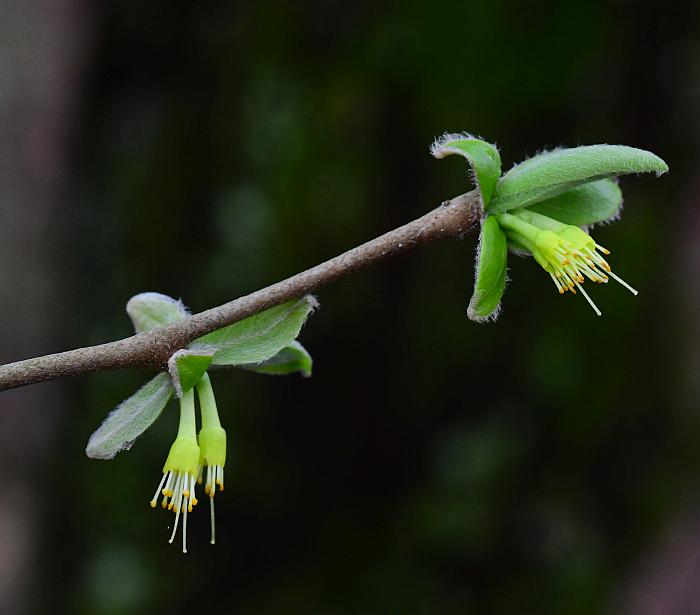Dirca decipiens Floden
Upland Leatherwood

Native
CC =
CW =
MOC = 2
© SRTurner
Dirca decipiens FlodenUpland Leatherwood | |
 |
Native CC = CW = MOC = 2 |
© SRTurner |
|
Family - Thymelaeaceae Habit - Shrub to 2 m Stems - Multiple from base. Twigs 3-5 mm wide, yellowish brown to gray-brown. First year growth densely pubescent with short, appressed, white hairs.
Leaves - Alternate, simple, short-petiolate to nearly sessile. Petioles 1-4 mm long, densely appressed-hairy. Leaf blades obovate to oblong, 2-9 cm long, rounded or broadly angled to a bluntly pointed tip, rounded or angled at the base, the margins usually relatively densely and finely hairy (mostly 11-18 hairs per mm), glabrate on the upper surface, densely pubsecent abaxially.
Inflorescences - Small clusters, typically with 2-4 flowers, appearing before the new leaves. Individual flowers sessile or nearly so, the minute stalks, if present, not elongating at fruiting. Persistent bracts 6-15 mm at flowering, continuing to enlarge to 40 mm or more as the fruits develop, oblong-obovate, the upper surface usually sparsely hairy along the veins, the undersurface woolly with dense, white to gray or tan hairs.
Flowers - Peduncle absent or nearly so. Calyces 7-11 mm long (including the hypanthium), with 4 distinct but irregular lobes 1-3 mm, the margin also irregular and/or minutely scalloped. Corollas absent. Stamens 8, exserted, the filaments of 2 lengths, attached in a ring to the inner surface of the calyx above the hypanthium portion, the anthers small, attached basally, yellow. Pistil 1 per flower, appearing composed of 1 carpel, the superior ovary sometimes with a minute, irregularly lobed nectar disc at the base. Style 1, slender, exserted and extending beyond the anthers, not persistent at fruiting, the stigma 1, minute, capitate. Ovules 1, the placentation more or less basal.
Fruits - Drupes 7-9 mm long, ovoid to ellipsoid-ovoid or slightly pearshaped, with an inconspicuous tuft of short hairs at the tip.
Flowering - March - April. Habitat - Upland wooded slopes and bluffs above rivers, often associated with oak and juniper. Origin - Native to the U.S. Lookalikes - Dirca palustris. Other info. - This species of leatherwood was first recognized as distinct from D. palustris by Aaron Floden in the early 2000s. It is believed to be quite rare, thus far having been identified in only six counties in Missouri, Arkansas, and Kansas. Due to its rarity, the plant is considered critically imperiled. Photographs taken at in Gasconade County, MO, 4-8-2021, and in Bel-Nor, St. Louis, MO, 4-2-2023 and 5-2-2023 (SRTurner). |